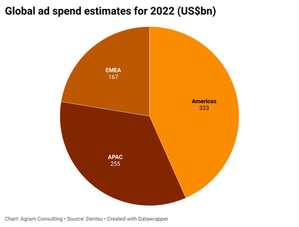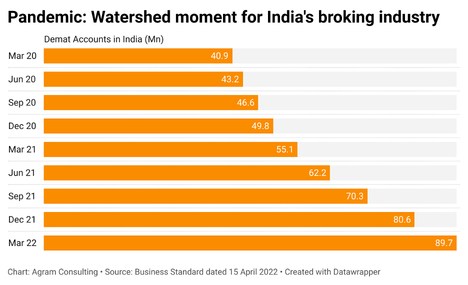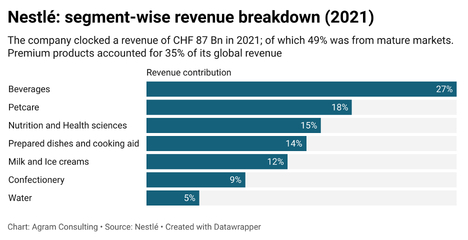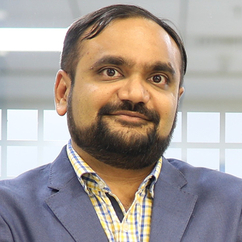IN THE SPOTLIGHT
Truly Moving the Needle
Balaji Vaidyanathan
As boundaries between the physical and the virtual world are narrowing, the agreed-upon difference between sales and marketing is also plunging.
A bewildering dilemma that CMOs and business leaders face today is how to break the silos and integrate these functions to improve organizational performance. A few leaders also find it challenging to make the best use of available data for growth hacking.
And how many of you are spending money in droves on ad campaigns and other marketing initiatives yet are not able to translate your efforts into earnings?
Data is the new oil — how often have you heard and used this expression in the past 4-5 years, which has become a run-of-the-mills phrase. But unfortunately, nobody precisely knows the actual value of data just yet. As the new oil makes tall claims about the future, the old oil has just started giving it a bloody nose—it has surpassed US$100/ bbl already.
The point to drive home here is: that productive marketers must understand future trends but not at the cost of what is still important. Because that's going to make you money today!
Even 2 decades ago, when I started my career in marketing, well-run futuristic organizations were data-driven and customer-centric. Yes, it was Excel sheet driven, but data was still crucial to the business. But now, why is data suddenly creating so much buzz? I believe it's partially because the scale of data available to marketers is unprecedented today. And to maximize the network effect, a business leader must use all data available to the organization productively and cost-effectively.
According to Dentsu, the ad spends forecast for 2022 for the global advertising market is likely to expand by 9.2% to reach US$745bn. Digital spends is likely to grow at 14.8% in 2022. With this, digital media will now command a 55.5% ad spend share globally.

And by 2024, digital may account for nearly 60% of the advertising market. In other words, performance marketing and digital experience may dominate now and in the foreseeable future.
But with these changes shaping the future of businesses, marketing is increasingly becoming a MAD place. So I thought, let's make it a GLAD place.
By MAD, I meant marketers across the globe are getting mesmerized by some of the most promising future trends—Metaverse, Agile, and Direct-to-Consumers. However, when it comes to following these and all such emerging megatrends, I think business leaders would generate more significant marketing ROI by being more, Gradual, Lucid, Analytical, and Demonstrative.
As you know, Jack Dorsey tokenized his first tweet in December 2020 and sold it to a crypto entrepreneur Sina Estavi, for US$2.9mn in March 2021. After much ado, the world nearly forgot about this iconic deal for a year. But, lately, when Sina Estavi placed it under the hammer in April 2022, he received a maximum bid of US$280.
Now, as a CMO, how would you summarize this episode? Yes, you may want to wear special specs of neutrality and respect all parties' freedom to price one's assets.
Many of us may argue that the product's value proposition—NFT—was next to nothing.
If we treat the NFT of Jack Dorsey as any other artwork having historical significance, we might appreciate that only a few art-lovers would know its real value. You see, the perceived value of a product is crucial. Some of us may even want to write down these losses as marketing and promotional expenses. Well, but the brouhaha it created was ephemeral.
If I were to learn some marketing lessons from these developments, I would remind myself to always be in sync with emerging megatrends—not race too far, not fall too behind. Does somebody over-committing to metaverse today sound more like investing in NFT having an obscure future?
And very importantly, please don't forget this: what worked for others in the industry would or wouldn't work for you. So, businesses must find their own winning formula. For instance, Zerodha, India's largest brokerage company, doesn't spend a rupee on active advertising and client acquisition. Moreover, it doesn't even offer any special reward when a customer opens an account with them.
So how did it manage to attain a perfect J curve?
To begin with, Zerodha launched a flat fee model targeting value-driven savvy investors who could sign up an account to save on brokerage and maximize their gains. Zerodha's value proposition didn't require any marketing blitzkrieg and word of mouth became its on-ground lead generation engine. The company's sales staff and associates worked more like a customer support team, and their job was to facilitate account opening and close deals by handholding customers.
The company kept up with technological advancements and launched its own online trading platform in 2015. Two years along the line, Zerodha gave its business another spin when it decided to waive off a fee of Rs. 50/month (less than a $) charged for using Coin, its online mutual fund distribution platform.
Clients acquired through Coin were a huge cross-selling opportunity for its sales team. And here too, intelligent marketing effort continued. Zerodha invested in an investor education initiative -Varsity. It worked like a catalyst in attracting gen-Z investors ready to experiment, take small bets to test their adrenal rush, and accept trading failures as practical lessons.
The runaway phase in Zerodha's growth story (the real kicker for the J curve) came during the pandemic.

You see, intelligent marketing is ever evolving. It never stops. Great product ideas don't always come through boardroom brainstorming. Nor do they occur only when you hire a consultant.
For that, marketers must stay in sync with industry trends and always put their customer behaviour under the scanner. When you have good products supported by intelligent marketing, you need not hard-sell to sell. Modern-day marketers must realize this convergence.
Take another example.
Nestlé is a famous global food and beverages company with a well-diversified product portfolio. The company has invested in digitization and innovation, thereby substantially bringing down time from concept to shelf. Moreover, Nestlé's decentralized structure enables it to spot the rapidly changing consumer demand and preferences trends early and manage supply chains effectively.

Over the last few years, the company has restructured its businesses and recalibrated its marketing strategies. Its impact marketing and environmental and sustainability commitments have created a high organic demand for its product portfolio.
The company's marketing goals go far beyond just creating awareness for its products. It's been taking up issues such as regenerative agriculture and biodiversity, which are of now-or-never priority for the wellbeing of the world.
And it's not just engaging in hollow marketing gimmicks. In fact, Nestlé is committing money to these causes. The company is expected to spend CHF 3.2Bn by 2025 to deal with climate change, and by 2030 it aims to source half the agricultural raw materials from regenerative sources. Nestlé produces nearly 83% of its coffee through sustainable practices at present. It's aiming for 100% by 2025.
The company also uses influencer marketing effectively. For example, it recently joined forces with Chiara Ferragni—an Italian blogger and fashion designer, to promote Nespresso.
Such concerted and marathon efforts provide a solid foundation for Nestlé's sales and distribution team to make its pitch.
Despite challenging times, Purina—Nestlé's pet food brand—successfully launched premium products during the pandemic and managed to grow in double digits. In addition, Purina's success helped the company accelerate its e-commerce revenue rapidly.
And hence I reckon customers today are more likely to engage with a company that shares their values and opinions. They are more inclined to buy products and services of a brand they agree with. And in most such cases, sales growth has little to do with price points.
And it's noteworthy that although the company still derives 84.9% of revenue from the offline business, it's expected to step up digital marketing spends by 50% by 2025. Don't you think its offline business will also get some traction from such high digital marketing spends?
Nestlé aims to grow its share of e-commerce by almost 100% over the next 3 years.
This brings me to my most important argument: you may sell online or offline, through active marketing or without any active marketing; the perception of your potential customers about your products is the key! If your product offers good value and if you can communicate it effectively, you win. Only effective communications won't help.
The basics of marketing have remained and will remain the same. And as cliché as it may sound—you should meet your customers where they can comfortably have a business discussion with you. And offer them products/services having high perceived value for the right price. This is a time-tested formula to improve the top line through effective marketing. Don't be afraid to revisit the 7Ps of marketing.
PS: I would like to add an 8th P: Purpose.
Balaji Vaidyanathan is an accomplished global marketing leader with 20 years of insightful experience in brand, advertising, digital, content, and mainline. In his current role since February 2019, he is responsible for building the marketing value proposition, brand digital presence and strategic footprint across CEEMEA. He also drives marketing efforts for a global strategic project to launch the first ever fintech wealth management platform in Germany as part of a broader European market penetration strategy.


BE THE FIRST TO COMMENT